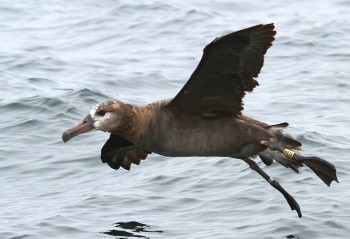Amanda Gladics (Department of Fisheries and Wildlife, Oregon State University, Newport, USA) and colleagues have published in the journal Fisheries Research on the use of bird-scaring lines and night setting in a North Pacific demersal fishery.
The paper’s abstract follows:
“Bird scaring lines (BSLs) protect longline fishing gear from seabird attacks, save bait, reduce incidental seabird mortality and are the most commonly prescribed seabird bycatch mitigation measure worldwide. We collaborated with fishermen to assess the efficacy of applying BSL regulations from the demersal longline sablefish fishery in Alaska to a similar fishery along the U.S West Coast. In contrast to Alaska, some U.S. West Coast vessels use floats along the line to keep hooks off the seafloor, where scavengers degrade the bait and the target catch. Our results confirmed that BSL regulations from Alaska were sufficient to protect baits from bird attacks on longlines without floats, but not baits on longlines with floats. Longlines with floats sank below the reach of albatrosses (2 m depth) at a distance astern (157.7 m ± 44.8 95% CI) that was 2.3 times farther than longlines without floats (68.8 m ± 37.8 95% CI). The floated longline distance was well beyond the protection afforded by BSLs, which is approximately 40 m of aerial extent. Black-footed albatross attacked floated longlines at rates ten times more (2.7 attacks/1000 hooks, 0.48–4.45 95%CI) than longlines without floats (0.20 attacks/1000 hooks, 0.01–0.36 95% CI). Retrospective analysis of NOAA Fisheries Groundfish Observer Program data suggested that seabird bycatch occurs in a few sablefish longline fishing sectors and a minority of vessels, but is not confined to larger vessels. Analysis also confirmed fishermen testimonials that night setting reduced albatross bycatch by an order of magnitude compared to daytime setting, without reducing target catch. Night setting could be an effective albatross bycatch prevention practice if applied to the U.S. West Coast sablefish longline fishery and provide a practical alternative for vessels that elect to use floated longlines. These results highlight the importance of understanding region-specific longline gear modifications to identify effective bycatch reduction tools and the value of working collaboratively with fishermen to craft solutions.”
Read popular articles on the paper here and here.

Twin bird-scaring lines keep birds at bay on a USA West Coast longline vessel, photograph by Amanda Gladics

Black-footed Albatross at sea, photograph by Vicki Miller
Reference:
Gladics, A.J., Melvin, E.F., Suryan, R.M., Good, T.P., Jannot, J.E. & Guy, T.J. 2017. Fishery-specific solutions to seabird bycatch in the U.S. West Coast sablefish fishery. Fisheries Research 196: 85-95.
John Cooper, ACAP Information Officer, 11 October 2017

 English
English  Français
Français  Español
Español